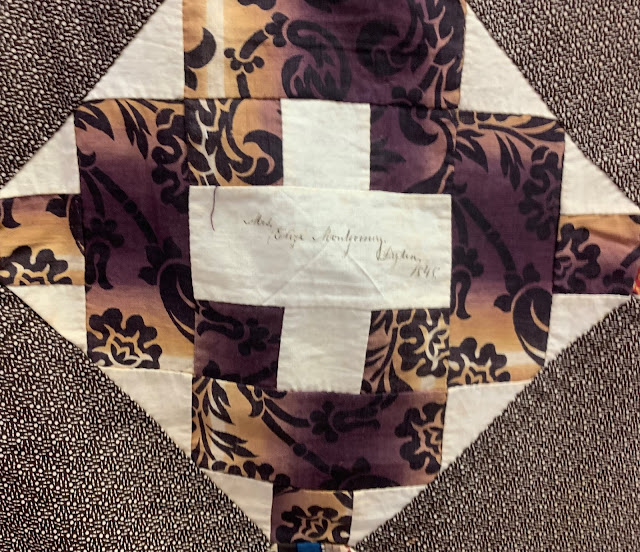Genealogists gather facts about their ancestors.
We look for birth, marriage and death records. We search for newspaper
articles, land records, wills, family Bibles, photos, etc. Anything that can help
fill in the blanks about our ancestors’ lives. Have you ever thought about a
quilt telling a story about your ancestors? Have you been lucky enough to
inherit a family quilt?
Several weeks ago I was
able to attend a talk about a quilt top. A dear friend, who is also a
genealogist, asked if, while I was visiting, I’d be interested in attending a
talk about a quilt top that had names, dates and towns listed on it. While I
had no ancestors in the particular county the quilt seemed to be from it was a
neighboring county to where some of my ancestors lived. The idea of researching
a quilt seemed intriguing to me. Spending time attending this event with my
friend sounded like a great thing to do. After all, when have you ever done
research on a quilt? What would be involved in researching a quilt? What can be
determined by researching a quilt? How would this research compare to what I do
as a genealogist? Who knows, maybe I’d learn something new about my ancestors.
The talk was sponsored by the Dryden Town Historical Society. We met at Dryden United Methodist Church on a Thursday evening. The speaker was Anita Loscalzo. The quilt was purchased at an auction in Massachusetts. Anita is a member of the American Quilt Study Group. Have you ever heard about or been involved with the American Quilt Study Group? Prior to this talk I knew nothing about the existence of a group that studies and researches quilts. Their Mission Statement-“The American Quilt Study Group establishes and promotes the highest standards for interdisciplinary quilt-related studies, providing opportunities for study, research, and the publication of works that advance the knowledge of quilts and related subjects.”
Anita started by detailing her vast research, which included:
- the names (30 women and 21 men)
- dates (1846-1849)
- towns handwritten on the quilt (primarily from Dryden,
Tompkins County, NY but also a few from Chemung and Greene Counties as
well)
- ages of names on the quilt top at the time the date was
recorded (from 11-69)
- the relationships of the people named (several people
were related but others were not)
- makeup of the quilt top itself-
- the number of stitches per inch
- the types of fabrics used
- the manufacturer of the fabrics
- what stores in the area at the time might have sold
these fabrics
- the types of ink used at the time, etc.
From this information
she determined most likely two people wrote the names on the quilt and two
people worked on piecing the quilt top together.
After Anita gained all
the information she could about the makeup of the quilt she then wanted to know
what was the purpose of these names and dates being together on one quilt top?
After researching surnames, religious affiliations, town histories, political
happenings from 1846-49 including Abolitionism, Temperance Movement, Turnpikes/migration patterns in
the mid-1800s in the area, Military tract land divisions, etc. Anita’s conclusion
after doing her research is that the people whose names were on the quilt were
probably participants in the Temperance Movement at the time and the dates may
have been when they made or renewed their Pledge of Abstinence. We will never
know for sure but based on the information from the time this seems like the
most probable reason for the group of names that were on the quilt.
Why the quilt top was never put together as a
finished quilt we’ll never know. We’ll never know who the two people
were that pieced the top together and wrote the names on the quilt. The fact
that it was most likely folded up and set aside for about 170 years probably
helped preserve the handwritten names, dates and places. It looked like they
had just been written yesterday. The fabric pieces were still very vibrant in
color, due to the types of fabrics used, the coloring at the time and
partially due to this only being a quilt top and I doubt not washed much over
the last 170 some years.
Hearing about Anita’s research and how she approached her task was very interesting. A lot of what genealogists do is similar in the way we research, the tenacity we show. Hearing about all the aspects of what and how she researched was so very fascinating. If you are fortunate to have inherited a family quilt remember to not only research the person who made the quilt but how and why the quilt itself was constructed. You may learn some interesting tidbits about your own family history by researching the quilt.
Enjoy the journey,
Debby
If you enjoy quilts, be sure to check out the New England Quilt Museum in Lowell, Massachusetts when you are in the area.




How very interesting. I will share this with my friend Chris who is a master quilt maker.
ReplyDelete